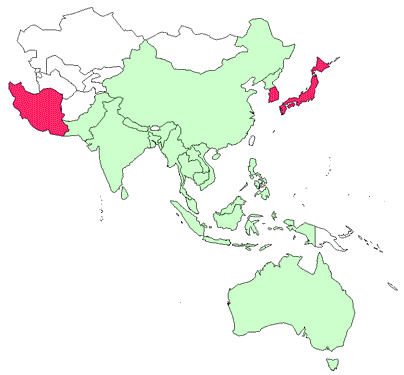Diseases of finfish
Viral diseases—Infectious pancreatic necrosis
CLICK ON IMAGE TO ENLARGE

Source: T Håstein
Signs of disease
Important: animals with disease may show one or more of the signs below, but disease may still be present in the absence of any signs.
Disease signs at the farm level
- mortality from 10% to 90%
Disease signs at the tank and pond level
- low persistent mortality
- sudden and progressive increase in mortality at first feeding of fry, particularly in faster growing individuals
Clinical signs of disease in an infected animal
- fish lie still on bottom
- fish swim with a spiralling, corkscrew motion
- white faecal casts
- swollen belly
- darkening body colour
- exophthalmus (pop eye)
Gross signs of disease in an infected animal
- lesions and ulcers in pancreas, oesophagus and stomach
- intestines empty or filled with clear mucus
Disease agent
Infectious pancreatic necrosis (IPN) virus is a birnavirus, many types of which infect marine finfish and shellfish but do not cause disease. The signs above are of the virulent disease in salmonids.
Host range
Fish that are likely to be severely affected by IPNV:
Atlantic salmon* (Salmo salar)
brook trout* (Salvelinus fontinalis)
brown trout* (Salmo trutta)
danio zebrafish* (Danio rerio)
rainbow trout* (Oncorhynchus mykiss)
yellowtail* (Seriola lalandi)
Other species known to be susceptible to variant strains of birnavirus:
amago salmon* (Oncorhynchus rhodurus)
Arctic char* (Salvelinus alpinus)
Atlantic menhadden* (Brevoortia tyrannus)
carangids* (Carangidae)
chinook salmon* (Oncorhynchus tshawytscha)
chum salmon* (Oncorhynchus keta)
cichlids* (Cichlidae)
coho salmon* (Oncorhynchus kisutch)
common scallop* (Pecten maximus)
cutthroat trout* (Salmo clarkii)
cyprinids* (Cyprinidae)
Danube salmon* (Hucho hucho)
drums/croakers* (Sciaenidae)
eels* (Anguilla spp)
grayling* (Thymallus thymallus)
halibut* (Hippoglossus stenolepis)
herrings/sardines* (Clupeidae)
Japanese amberjack* (Seriola quinqueradiata)
lake trout* (Salvelinus namaycush)
lampreys* (Petromyzontyidae)
left-eye flounders* (Bothidae)
loach* (Misgurnus anguillicaudatus)
loaches* (Cobitidae)
masou salmon* (Oncorhynchus masou)
Pacific salmon* (Oncorhynchus spp)
perches* (Percidae)
pikes* (Esocidae)
silversides* (Atherinidae)
sockeye salmon* (Oncorhynchus nerka)
soles* (Soleidae)
Southwest European nase* (Chondrostoma toxostoma)
striped snakehead* (Channa striatus)
suckers* (Cotostomidae)
summer flounder* (Paralichthys dentatus)
turbot* (Psetta maxima)
white seabass* (Moronidae)
whitefish* (Coregonidae)
carp (Cyprinus carpio)
goldfish (Carassius auratus)
redfin perch (Perca fluviatilis)
southern flounder (Paralichthys lethostigma, estuarine)
yellowfin bream (Acanthopagrus australis)
Asymptomatic carriers of related birnaviruses worldwide are:
coalfish (Pollachius virens)
common carp (Cyprinus carpio)
discus fish (Symphysodon discus)
goldfish (Carrasius auratus)
heron (Ardea cinerea)
loach (Cobitidae)
minnow (Phoxinus phoxinus)
noble crayfish (Astacus astacus)
pike (Esox lucius)
river lamprey (Lampetra fluviatalis)
shore crab (Carcinus maenas)
Spanish barbel (Barbus graellsi)
white suckers (Catostomas commersoni)
whitefish (Coregonidae)
* naturally susceptible (other species have been shown to be experimentally susceptible)
Presence in Asia–Pacific

IPN has been officially reported from Iran, Japan and the Republic of Korea. A related birnavirus has been identified in the marine environment off Tasmania, Australia, and another from New Zealand in diseased turbot and asymptomatic sea-run chinook salmon.
Epidemiology
- IPN is highly contagious.
- Transmission of the virus to uninfected fish is via water. The virus enters fish through the gills and by ingestion.
- IPN is also vertically transmitted via eggs.
- The virus enters the water in faeces, urine, spawning fluids and external mucus, and through contaminated transport water, contaminated eggs and blood-sucking parasites of infected fish.
- Fish-eating birds can also be a source of the virus to the environment.
- Outbreaks are most likely to occur around spawning, with increased levels of virus excreted to water with spawning fluids.
- Cumulative mortality can vary from 10% to 90%.
- IPN affects postsmolt Atlantic salmon eight weeks after transfer from freshwater to seawater.
- The disease can cause high mortalities in young trout.
- The virus is both freshwater and marine tolerant.
- Fish that survive IPN are presumed to be carriers of the virus.
- The virus is not host-specific, having been found to affect fish of at least 20 different families.
- Pathogenicity depends on virus strain, species and age of host, and the environment.
- The virus is quite stable, enabling it to persist in a range of environmental conditions, and resists destruction by disinfection.
Differential diagnosis
The differential diagnostic table and the list of similar diseases appearing at the bottom of each disease page refer only to the diseases covered by this field guide. Gross signs observed might well be representative of a wider range of diseases not included here. Therefore, these diagnostic aids should not be read as a guide to a definitive diagnosis, but rather as a tool to help identify the listed diseases that most closely account for the gross signs.
Similar diseases
Viral haemorrhagic septicaemia, infectious haematopoietic necrosis
Sample collection
Because of uncertainty in differentiating diseases using only gross signs, and because some aquatic animal disease agents might pose a risk to humans, you should not try to collect samples unless you have been trained. Instead, you should phone your national hotline number and report your observations. If samples have to be collected, the agency taking the call will advise you on what you need to do. Local or district fisheries/veterinary authorities could advise you on sampling.
Emergency disease hotline
For your national emergency disease hotline number, see Whom to contact if you suspect a disease.
Further reading
http://www.oie.int/aac/eng/cards/en_diseasecard.htm
The currently accepted procedures for a conclusive diagnosis of IPN are summarised at http://www.oie.int/eng/normes/fmanual/A_00025.htm
These hyperlinks were correct and functioning at the time of publication.

